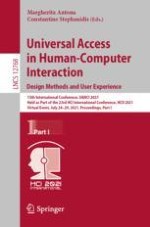2021 | Book
Universal Access in Human-Computer Interaction. Design Methods and User Experience
15th International Conference, UAHCI 2021, Held as Part of the 23rd HCI International Conference, HCII 2021, Virtual Event, July 24–29, 2021, Proceedings, Part I
Editors: Dr. Margherita Antona, Prof. Constantine Stephanidis
Publisher: Springer International Publishing
Book Series : Lecture Notes in Computer Science
